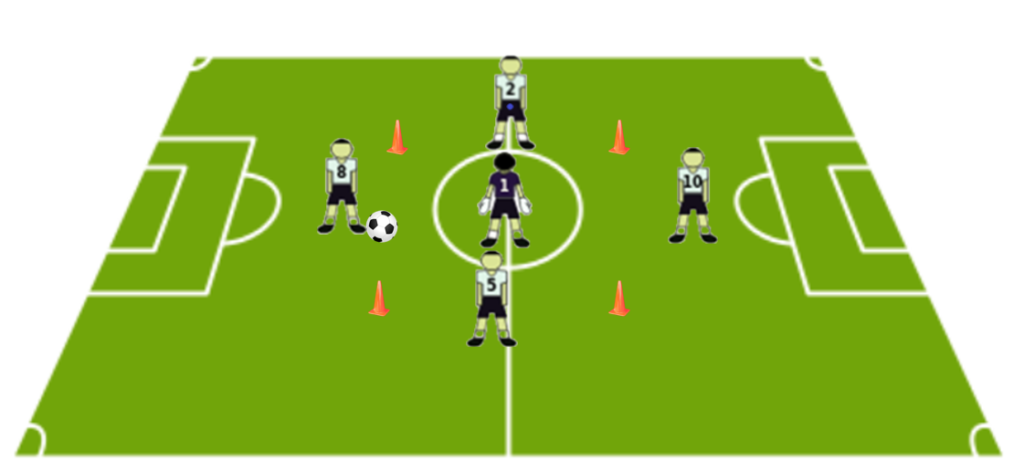4v1 rondo [Complete Guide for Coaches]
Now that we understand how to do no opponent rondo by mastering 3v0 and 4v0, it is time to move to add an opponent. By now the players should understand the basic setup of the rondo, as well as the importance of using the backfoot. They will be aware of the weight of the pass, as well as the idea of moving off the ball to create space and the decision of a one-touch pass vs receiving the ball then passing. I expect to be able to start the 4v1 rondo after about a month, or 6-10 sessions of no opponent rondo. If they can do 10 passes in a row, they are ready for some pressure.
4v0.5 rondo
In this case, the coaches are half of a defender, playing to add a bit of difficulty, but the pressure should be at a fraction of what other teammates can do. That means you are cheating – there are opponents. Yes, it’s a little bit of cheating. However, it is important to understand that when players are very young, they cannot and shouldn’t understand when you ask them to put 50% pressure. You don’t want to create a habit when you ask them to give less than their best. Additionally, they will always give their best when the coach is the defender, which is what we all want.
I would suggest trying to jump in and out when the players have their 4v0 rondos to create pressure from time to time. It will also give you an idea if they are ready for regular 4v1 rondo, which is the next building block.

4v1 rondo
Finally, time to do a real rondo! Firstly, make the space big. You want them to have the space and to try and retain the ball. They should be able to do some 3 passes from the first practice, but if they do double-digits consistently, then it’s too easy. They will already know the soccer diamond setting from the previous drills, but the pressure is there this time around.
Rule for the defender
The first rule for the defender is to let the first pass be free. I technically don’t want to phrase the rule that way because that often makes the first pass sloppy. Instead, I ask the player to be right in the middle when the first pass occurs. If the player with the ball decides to pass through the middle, it’s fair play to intercept the ball.
The second question is how do we switch the player in the middle. The traditional one is to switch as soon as the majority loses the ball. However, at this age, I like to challenge the defender to intercept as many balls as possible in one minute. That way the drill is fast, instead of the defender kicking the ball far away and waiting for a minute for somebody to get it back. Another benefit is that the players that need to kick the ball the most end up in the middle in the first scenario, playing with the ball even less.
Variations of 4v1 rondo games
There are many variations of games you can have, we outlined two above. Creating new practices gives freshness to the competition.
1. Number of interceptions by the defender in a minute
2. Player loses the ball goes back in the middle
3. Two rondos side by side competing for more passes
4. Two rondos side by side with goals available for scoring after 10 passes
5. One pushup for the defender for every 5 passes completed (eg. 17 passes before interception equals 3 pushups)
RONDOS
No Opponents Rondo
Introduction to rondos with 3v0 and 4v0. Coaching passing, receiving, and the concept of “backfoot”.
First opponent
Introduce an opponent in the rondo. Create the need to move off the ball and think of passing lanes.
Increase intensity
Limit one passing option, and improve decision-making. Put pass-and-go into practice. Introduce a transition rondo to 5v3.
Increase complexity
Introduce team pressing of two players. Coach the central midfielder for the first time.
Pro Rondo
The rondo that pros play. Teaching to split the opponents with the right weight of the pass.
Positional play
All variations of the complex rondos before transitioning into positional play and game scenarios.

